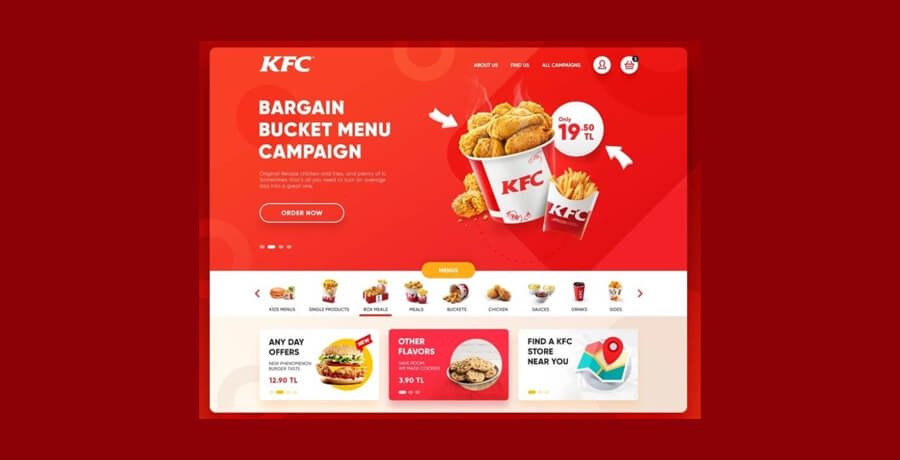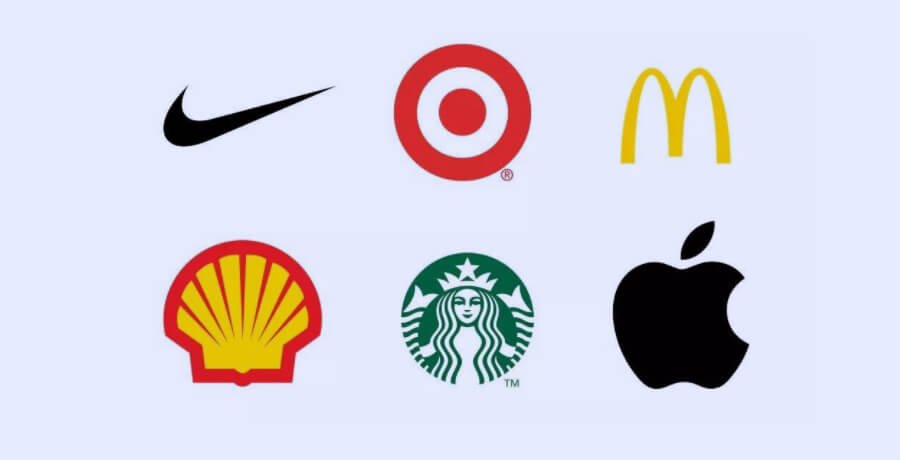Understanding the Importance of Visual Identity for Brand Success
Brands are like humans where some are awesome and some are (less) awesome!
But what makes the popular brands stand out and what causes them to appear unattractive and a creative disaster?
It’s the visual identity that can strengthen your brand’s overall perception in the market!
Let’s see if you can guess this brand right via its basic visual identity components, below.
It uses black color, has an alternative Myriad Set font, and there’s a bitten apple.

I’m sure you’d have said Apple instantly, right?
That’s how the visual identity helps you not just in guessing the brand but in remembering it!
Of course, Apple does invest its energy, time, and money in other branding recipes such as brand voice, marketing copy and brand tone. But visual identity is something different and something that helps their brand stand out even before you read the message or watch the DVC.
That’s the power of having a strong visual identity that makes a brand stick in your mind.
What is Visual Identity?
Before I tell how you can create a strong visual identity for your brand, I want your 60 seconds to explain what is visual identity in graphic design?
To answer it in a simple, understandable manner, a visual identity basically comprises several graphic and visual elements that together define your brand. These elements include your brand’s logo design, typography, color selection, and photography used to form a visual message.
The key objective, here, is to develop a strong (and preferably) positive impression of your brand with these basic design components.
Let suppose that your brand is a human or say a popular guy from your workspace (Eddie). And he’s considered a prodigy in comic books and movies. Now, whenever you feel confused about a movie’s plot, you think of Eddie, who can explain it to you in an easy, understandable manner.
This quality of being recognized for something, some ability is what you can relate to your brand’s visual identity!
Your brand’s visual identity is what remains in the subconscious mind of your consumers that reminds them whenever they’re looking for products similar to your offering. Or, take it as an unspoken introduction or an image of your brand that people perceive and make opinions about.
Is Brand & Visual Identity Same?
Now some of you may be confusing visual identity with the brand identity or the word branding!
See, the brand identity is a broader concept and the visual identity is a part of this mechanism with which the brand manages to maintain its public image and increase conversion rate.
Look at the online brochure, below, where KFC is promoting its “Bargain Bucket Menu Campaign”.

Credits: Selim Özkök
The page’s hero section contains a chicken bucket along with fries and the price tag for the whole deal. The imagery, the background color, and the typography all are part of KFC’s visual identity here.
But if we talk about brand identity, it’s the whole marketing idea to promote this “Bargain Bucket Menu Campaign” and it literally includes everything from graphic elements, brand voicing, and the marketing copy used on the page.
Here are some points that you must consider for further understanding the key differences between both the terms:
- Visual identity is basically the outer, tangible shell of your brand whereas the brand identity is an abstract image of how people look at your brand.
- The visual identity comprises several design elements such as the typography, images, logos, and color schemes whereas the brand identity contains more than just design elements.
- Brand identity is designed and handled by marketers and project managers whereas the visual identity is the product of a logo or brand designer’s efforts.
Essential Visual Identity Components
Until now, we only talked about the core definition of visual identity and how it is different from branding or brand identity.
But what makes a visual identity possible for a brand?
It’s the four basic elements like logo design, color palette, fonts, and images that combine to help a brand say something graphically.
If we talk about visual identity and its components, there are various options that I might want to include in the list keeping current marketing platform options in mind. But let’s stick to the basic components that are visible in every brand’s visual identity. Continue reading and discover these key visual identity elements, below, and how they contribute to your brand’s success.
An important read for you: 9 professional logo design benefits you hardly know about
Logo Design
Logo, or a company’s corporate face, or a symbol to identify a brand, there are various names to address the essential visual identity component that, I strongly feel, has a very significant importance in this whole identity concept. A logo not just makes the remembrance part easy for your consumers but performs various other applications for your brand.
Simply put, your logo design is a sign of who you are as a brand and what exactly you do for your consumers.
Look at the logos below and you can easily tell what each brand does, don’t you?

Sure, there’s a whole journey behind reaching to this point where they don’t have to include their name as you can understand what each brand stands for just by looking at their logos only. This is the kind of effect you can have on your brand if you play the visual identity card right.
Generally, there are two main types of logos that you can include in your brand’s visual identity. Each type offers you particular features that make your selection suitable for your brand.
Organic Shapes – Using organic shapes in your logo design allows you to portray your brand as a kind, fun, refreshing, and friendly option.
Geometric Shapes – The use of geometric shapes in your brand’s logo gives it a rigid, powerful, durable, and innovative feel.
Color Scheme
Just like we make certain opinions about everyone we meet via their skin tone, color scheme is another important part of your brand’s visual identity. It serves as a bridge between your brand and the human mind (and heart as well) for developing an emotional connection.
Each brand has a different color to associate a certain feeling with it that their consumers find appealing. McDonald’s yellow arches, Baskin Robbins Honolulu Blue & Raspberry Pink, and Coca Cola’s red wordmark are all famous examples of how brands incorporate colors in their branding.

Apart from that, there are certain rules to pick the right color scheme for an accurate visual identity. Consider these rules while selecting the right brand colors:
- There should be one main color to represent your brand.
- Then, derive 2 primary colors based on that main hue that you earlier selected.
- Also, seek 3-4 complementing colors for making your visual identity appealing.
- Pick at least 2 accent colors to shift the attention on your CTAs.
In the beginning, your color selection focuses on the brand’s logo design but later it expands on other creative materials such as brochures, website pages, company profile and what not. Also, there’s a study (conducted by Cardiff Business School) that suggests people tend to choose a brand that uses appropriate, relevant color options in their visual identity. So, doing this would allow your visual identity to stay relevant and focused on your branding guidelines throughout the brand creation and promotional course.
You may find it helpful: How is Color Psychology connected to a brand’s success?
Typography
The third important component of a brand’s visual identity is its typography or font selection!
This element is visible in almost every branding property including brand’s logo to marketing copy and other graphics. In order to understand the true application of typography in a brand’s visual identity, here’s an example:
Suppose, your brand is a human (the same guy, Eddie) and you’re meeting him after a long time. Apparently, he looks in shape, muscular body, nice dressing sense and all but when he speaks, his voice is a little squeaky. And this is the moment that pleasant vibe vanishes and you might misunderstand him as someone with anger management issues.
Let’s dissect Eddie’s overall personality and see how the typography point fits in it. He’s a nice muscular body (the logo), good clothing sense (the color selection) but heavy voice pitch (bad typography) when he speaks, he scares everyone off in the room.
So, here’s my take from the analogy that I’ve just shared with you above:
- Typography is as important as paying attention to your brand’s logo design.
- Each brand demands a different set of font families to keep the brand tone on a normal level.
- And lastly, the font must be legible in every size when you want to display your logo or any brand message in variable sizes.
Photography
Photography is the fourth and the last basic visual identity element that you must not neglect or skip while shaping your brand’s exterior, visually tangible image. The use of photography includes still images, video content or any animated content that can amplify your brand’s core message without the use of lengthy paragraphs.
Ideally, the photo selection should come with the key branding guidelines that narrate which images are eligible to represent your brand’s visual identity and which are not relevant to your brand. There are certain benefits for including images and video content in your brand’s visual identity:
- Make your branding relevant and appealing with relatable photography for your consumers.
- With the inclusion of photos and videos in your branding efforts, you can increase the engagement rate of your brand, too.
- Text might be a good option to tell your brand’s story but photography eliminates the need to read for understanding what you are as a brand and what you offer.
- People like interacting with brands who make use of imagery as it makes it easy for a viewer to remember you via a certain image use.
Why is Visual Identity Important for Brand Success?
If you’re new to branding and graphic design and stuff, you might feel that investing on a brand’s visual identity is an extra (or unnecessary) work. That’s where professional graphic design services quietly work their magic.
Come, let me give you a closer look on how having a strong visual identity can benefit your brand in the long run, below:
Can you name the brand having a leaping cougar, or a mermaid, or maybe the colliding red and orange balls?

What? Say louder!!!
Did you answer Puma, Starbucks and MasterCard?
Great, but have you noticed how you guessed them all so accurately even when there was no mention of the brand name?
It’s because you recognize these brands not just by their names but via the logo (or should I say the visual identities that are the logos in this case?).
A few years back, MasterCard used to print its name next to the logo on everything they ever offer. But they switched to the nameless logo elements only risking their brand recognition. But this removal didn’t really impact their brand in terms of consumer selection rate as everyone knows its them.
This is all due to having a strong (and accurate) visual identity that they invested in. And now, its your turn to prepare your brand for such a strong brand recognition that people can identify you even if there’s no mention of your brand’s name.
How to Develop Your Brand’s Visual Identity?
Wondering how these successful brands manage to create a strong visual identity for them?
The secret is they first worked on the brand style guidelines that kept them on the same page throughout their branding journey especially when it came to the visual identity part.
Let me share some essential points, below, that you must get right in order to have an irresistible and awesome visual identity for your brand.
Understand Your Consumers
Your consumers are the ultimate receivers of every branding effort!
Start with understanding who they are before you start working on your visual identity. For that matter, devise buyer personas to better understand who your actual buyers are and how they’d respond to your marketing efforts including the visual identity of your brand.
If not everything, start with these essential metrics to create semi-fictional characters of your exact buyers:
- Name
- Gender
- Age
- Occupation
- Education & Income
- Lifestyle Preferences
- Interests
- Key Challenges
Knowing who they are, what they do, and what particular feature they seek in a brand would allow you to align your brand’s visual identity with it.
Work on Brand’s Purpose
In order to keep your visual identity on the right track, you must evaluate what exactly it is that your brand started?
Knowing this is also important to give your brand a proper direction and select “what to do” and “what to avoid” when promoting your brand. If you’ve no idea how to define (or redefine) your brand’s core purpose, try answering these questions:
- Why exactly are you offering your services/products?
- How does your brand help the key consumer?
- What is your brand’s short-term/long-term goal?
- Does your brand represent the mission statement properly or not?
- What particular visual element represents your brand’s purpose accurately?
Understand Key Visual Elements
Once you understand who your consumer is, take some time to study the key visual elements with which you’re planning to impress them.
See, each visual element (logos, fonts, colors, and imagery) works differently and you must maintain hha proportion in each of them to give your brand a pleasing feel.
Some colors offer an aggressive feel and some give a soothing touch. Similarly, some fonts are considered old-school and some are contemporary. The key here is to maintain proportion in everything that you’ll ever use to form your brand’s visual identity.
In simple words, learn to work with each element individually so when you jot them together, you know what each puzzle would do to your brand’s overall image.
Tell A Compelling Brand Story
People don’t just buy products they seek the story the brand has to offer!
It’s not just a bike that you purchase, you also ride the pride bind by Harley Davidson. Or say, you’re not buying your morning coffee, you’re carrying the prestige of Starbucks in your hand as you take the train to work.
Brands make use of visual identities to tell their journey, their story so people can make connections with them.
In order to conclude if your brand is headed in the right direction, answer these questions:
- Do we make connections with the consumers with our brand story?
- What’s the first response of our clients after dealing with the brand and knowing its story?
- Is the story and consumer’s emotional response embedded in our visual identity?
You should also read: How Design Empowers Brand Storytelling?
Practice Consistency & Contrast
When you’re trying to promote your brand, you won’t be focusing on the single medium to market it. You’ll be using a number of platforms and marketing collaterals and they all should look similar to each other.
While you seek help with the visual identity, make sure that every part of your marketing collateral is identical to other components in terms of design, market copy, and basic creative ideas. To make it simpler, you must maintain consistency and contrast in everything you ever produce to market your business.
Design Differently for Each Occasion
Keeping every design element similar is important but designing everything in the same manner may give your brand a redundant feel. In order to stay ahead of your competition via an impressive visual identity of your brand, you must pay attention to the occasion as well as the medium you’re designing for.
From brochures to online ads and websites, your visual identity must meet the design requirement and visual space in account. Doing so will help your brand portray the exact image with full context without disturbing the dimensions of the medium. So, do seek if your visual identity is maintaining the platform’s requirement or not.
Pro Tip + Endnote
Your brand’s visual identity can do wonders if done correctly or collapse the whole branding if you don’t know anything about it. Sure, you can define the main pillars around your branding plan but you need to have someone proficient in designing and brand visualization such as a graphic designer or a branding expert by your side.
Understand how each visual element plays its role in giving your brand a distinct image and hire a branding expert, today. Adios!
-

Waqas D.
Waqas D. is the co-founder of the branding and website agency, FullStop™. He supercharges brands by crafting memorable logos, brand identities and engaging websites. Besides thousands of startups and medium-size businesses, FullStop has worked with likes of Microsoft & L’Oréal. View our portfolio or get in touch.
Get a Free Quote
+1 845 3770255
Call on anytime
To discuss your project










